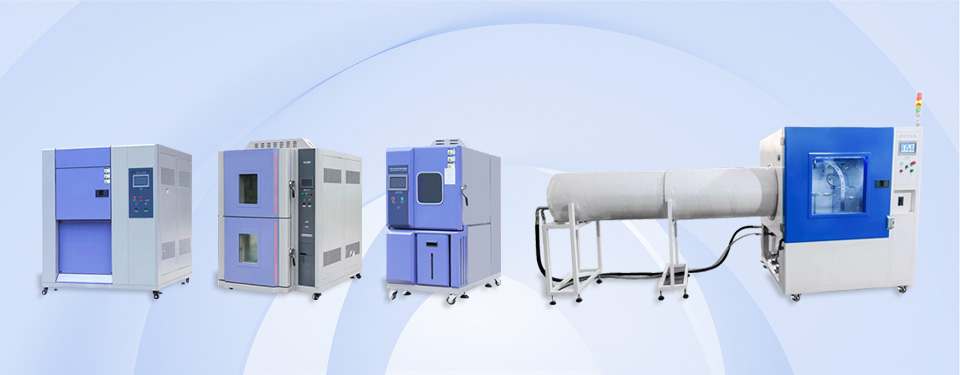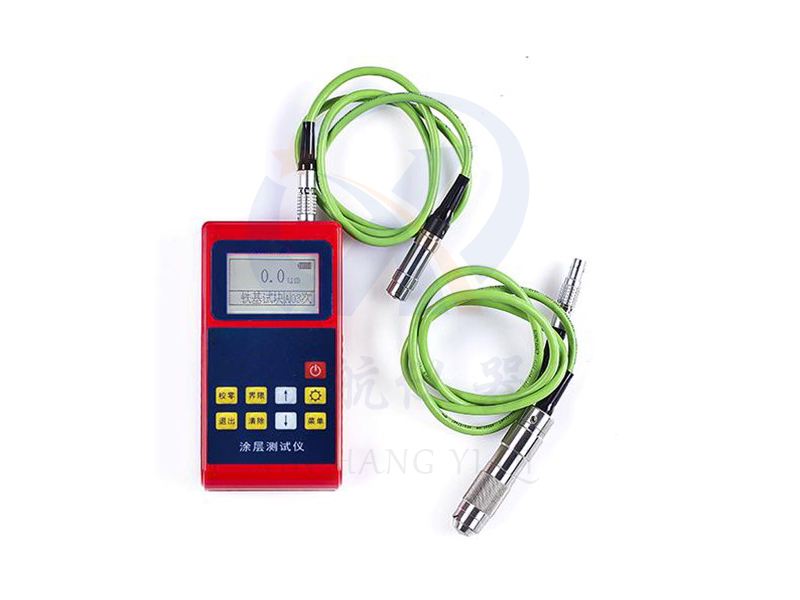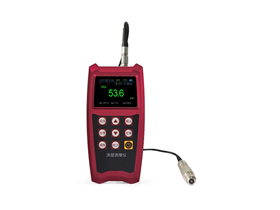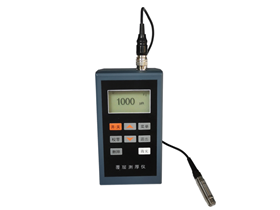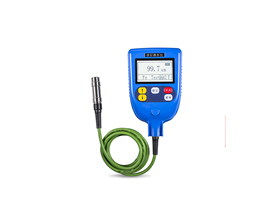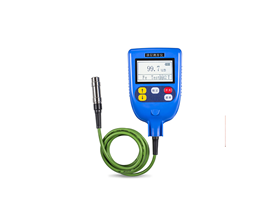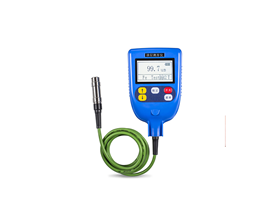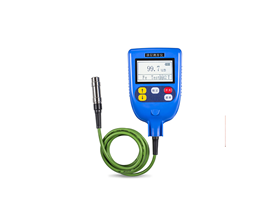summary
Two measurement methods, magnetic and eddy current, can be used to detect the thickness of non-magnetic coatings on magnetic metal substrates (such as aluminum, chromium, copper, zinc, tin, rubber, paint, etc. on steel alloys and hard magnetic steel), as well as the thickness of non-conductive insulation coatings on non-magnetic metal substrates (such as rubber, plastic, paint, oxide film, etc. on aluminum, copper, zinc, tin).
Coating thickness gauges are applied in testing fields such as electroplating, anti-corrosion, aerospace, aviation, chemical, automotive, shipbuilding, light industry, and commercial inspection. It can be used in both laboratories and engineering sites. Configure different probes for different occasions. It is an essential instrument in the testing industry.
major function
There are two measurement methods: continuous measurement and single measurement;
There are two working modes: direct and group mode;
● Equipped with automatic statistical functions: mean (MEAN), maximum (MAX), minimum (MIN), number of tests (NO.), standard deviation (S.DEV);
Two methods, single point calibration and two-point calibration, can be used to calibrate the instrument, and the basic calibration method can be used to correct the systematic error of the measuring head;
Storage function: can store 4 calibration workpieces that can be saved. Divided into 2 categories of workpieces, with 26 groups in each category and 15 pieces in each group, a total of 1560 measured values;
● Delete function: Delete individual suspicious data that appears in the measurement, or delete data in the storage area for new measurements;
● Setting limits: Automatic alarm for measured values outside the limit;
Equipped with power undervoltage indication function, with a buzzing sound during operation and automatic shutdown mode.
technical parameter
|
project
|
XH-TC-222
|
|
Probe type
|
F1/N1
|
|
operational principle
|
magnetic induction/Eddy current
|
|
measuring range
|
0-1250μM
|
|
Low resolution limit
|
0.1μM
|
|
Indication error
|
One point calibration
|
±(3% H 1)
|
|
Two point calibration
|
±[(1-3%) H 1]
|
|
Test conditions
|
Minimum curvature radiusMm
|
Convex1.5mmConcave9mm
|
|
Minimum area diameterMm
|
Φ7mm
|
|
Basic critical thicknessMm
|
0.5mm
|
|
work environment
|
temperature
|
0-40℃
|
|
humidity
|
20%~90%
|
|
source
|
AAAType alkaline battery1.5VTwo sections
|
|
External dimensions
|
115X68X25mm(Host)
|
|
weight
|
200g
|
|
Shell material
|
Plastic shell
|
|
Standard configuration
|
Host, standard test piece, iron substrate, alkaline batterymagnetic/Eddy current probe
|
|
Optional configuration
|
Standard test pieces, probesPCcommunication
|
Compliant with standards
1. GB/T 4956-2003 Measurement of non-magnetic coating thickness on magnetic metal substrates Magnetic methods
2. GB/T 4957-2003 Eddy current method for measuring the thickness of non-conductive coatings on non-magnetic metal substrates
3. JB/T 8393-1996 Magnetic and Eddy Current Coating Thickness Measuring Instruments
4. JJG 889-95 "Magnetic reluctance thickness gauge"
5. JJG 818-93 Eddy Current Thickness Gauge
measuring principle
This instrument adopts a thickness measurement method based on magnetic principles, which can measure the thickness of non-magnetic coatings on magnetic metal substrates (such as iron, cobalt, nickel) (such as aluminum, chromium, copper, enamel, rubber, paint, etc.). The principle of eddy current measurement is also adopted, which can measure the thickness of non-conductive coatings on non-magnetic metal substrates (such as copper, aluminum, zinc, tin, etc.) (such as enamel, rubber, paint, plastic, etc.).
A. Magnetic method (F-type probe): When the probe contacts the covering layer, the probe and the magnetic metal substrate form a closed magnetic circuit. Due to the presence of a non-magnetic covering layer, the magnetic resistance of the magnetic circuit changes. The thickness of the covering layer can be measured by the change in magnetic resistance.
B. Eddy current method (N-type probe): Using high-frequency alternating current to generate an electromagnetic field in the coil, when the probe contacts the covering layer, eddy currents are generated on the metal substrate, and feedback is generated on the coil in the probe. The thickness of the covering layer can be derived by measuring the magnitude of the feedback effect.

Measurement steps
A) Place the probe in an open space, press the power button to turn it on, and check the battery voltage.
explain
1: When the battery symbol is displayed at full capacity, it indicates that the battery voltage is normal; When the battery level is less than 2 cells, please replace the battery immediately to ensure measurement accuracy.
2: When not in use for a long time, the battery should be removed. Under normal circumstances during startup, the startup display interface is shown in the following figure:
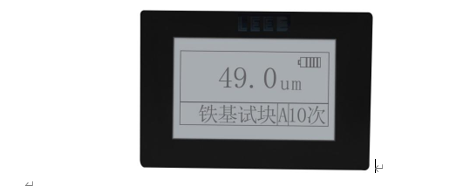
"Iron matrix" - F-type probe, testing object is an iron matrix
"A" - Last measurement mode before last shutdown
"Value" - the last measured value before the last shutdown
B) Choose appropriate calibration methods for standard instruments.
C) Measurement method: Hold the sliding sleeve and make vertical contact between the measuring head and the testing surface. With a beep, the screen displays the measurement value. Lift the side head to proceed with the next measurement.
D) Shutdown: Press the power button, or the instrument will automatically shut down after about 5 minutes.
Note: If the instrument automatically tests when turned on, please press the "zero calibration" button and perform a calibration of the five test pieces.
Explanation:
If the measuring head does not make vertical contact with the surface to be measured during measurement, a measurement value with a large error may be displayed. You can press the clear button to clear this value;
After measuring three or more times, the instrument can automatically perform statistical analysis on the measurement data, including average value, deviation, number of measurements, maximum measurement value, and minimum measurement value.
Maintenance and repair
1. Environmental requirements
Strictly avoid collisions, heavy dust, humidity, strong magnetic fields, oil stains, etc.
2. Replacing the battery
When the battery level on the screen is displayed as less than 2 bars when turned on, it indicates that the battery should be replaced.
3. Instrument maintenance
When a malfunction occurs, please do not disassemble the machine for self repair. After filling out the warranty card, please hand over the instrument to our company's maintenance department to comply with the warranty regulations. If you could briefly describe the situation where the error occurred and send it out together, we would greatly appreciate it.



